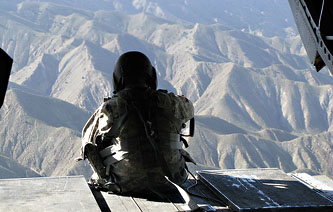 In the Washington Post today, Rajiv Chandrasekaran has an inside look at the Obama administration’s long deliberations over how to deal with Afghanistan. Jason Zengerle says it’s full of details that “make the Obama administration look more than a little inept.” Michael Crowley wonders how Obama’s first review, back in March, “came up so embarrassingly short.” Matt Yglesias says it “makes the Obama administration look pretty foolish.”
In the Washington Post today, Rajiv Chandrasekaran has an inside look at the Obama administration’s long deliberations over how to deal with Afghanistan. Jason Zengerle says it’s full of details that “make the Obama administration look more than a little inept.” Michael Crowley wonders how Obama’s first review, back in March, “came up so embarrassingly short.” Matt Yglesias says it “makes the Obama administration look pretty foolish.”
I’m not so sure. Here’s Chandrasekara’s gloss of how last March’s recommendation that we adopt a counterinsurgency strategy was intepreted at the time:
To senior military commanders, the sentence was unambiguous: U.S. and NATO forces would have to change the way they operated in Afghanistan. Instead of focusing on hunting and killing insurgents, the troops would have to concentrate on protecting the good Afghans from the bad ones.
And to carry out such a counterinsurgency effort the way its doctrine prescribes, the military would almost certainly need more boots on the ground.
To some civilians who participated in the strategic review, that conclusion was much less clear. Some took it as inevitable that more troops would be needed, but others thought the thrust of the new approach was to send over scores more diplomats and reconstruction experts. They figured a counterinsurgency mission could be accomplished with the forces already in the country, plus the 17,000 new troops Obama had authorized in February.
So the civilians screwed up. They wanted counterinsurgency on the cheap, but that was never in the cards. Now they’re scrambling to regroup.
Except that’s not really what Chandrasekara says. Later he explains why the March task force members thought that Obama’s previous commitment to send 21,000 more troops to Afghanistan was sufficient:
Encouraging the view that a massive influx was not needed were statements from the overall U.S. and NATO commander at the time, Gen. David D. McKiernan, who said he had shifted his troops toward counterinsurgency operations. He was not asking for more forces beyond the 21,000 Obama had agreed to, plus 10,000 more in 2010, which the Pentagon told the White House it could address later in the year.
“Typically, you defer to the field for the resource needs,” said one senior official involved in the review. “In March . . . we thought we had a handle on what McKiernan thought he needed.”
A military official familiar with McKiernan’s thinking said his request for 30,000 troops last fall was tempered by a belief that the Bush White House would reject it outright if he asked for more. As it was, Bush tabled the request, leaving it to Obama.
….”The military was not ready at that point to come to the president and say, ‘Here’s the number we think it’s going to take,’ ” the person familiar with the conversation said. “They were satisfied that what they had put on the table at the beginning of the administration met their requirement for the moment.”
If Chandrasekar’s account is correct, the fault isn’t really with the Obama administration at all. It’s with the military: McKiernan was on board with the counterinsurgency strategy but didn’t indicate that he needed more troops to implement it. Maybe this was because he was gun shy thanks to his experience with George Bush, maybe not. But one way or the other, he didn’t ask for more troops. And considering the obvious political sensitivity of a troop increase, you just can’t plausibly suggest that he somehow implied he needed one even though he never quite said so outright. If he wanted more troops, he would have said so.
Later, of course, McKiernan was pushed out and a new commander took a fresh look at what resources were needed. But that hardly reflects badly on Obama, and it doesn’t really sound like anyone screwed up back in March. Long story short, the military changed its mind about troop levels between March and September, and now Obama has to decide how to respond to that. I don’t really see a case for ineptness here, and I, for one, am perfectly happy that Obama and the generals are taking their time to hear everyone out and try to get things right this time around. After eight years of futility, it’s not as if a few more weeks to hash out internal differences and get some real consensus is a bad thing.








